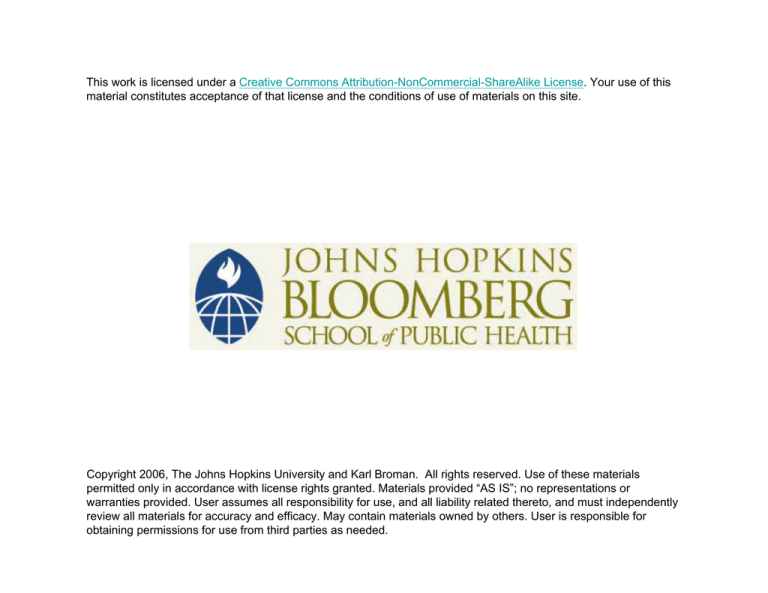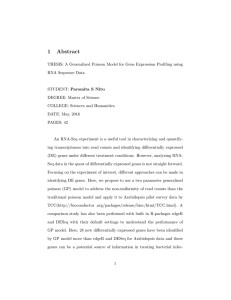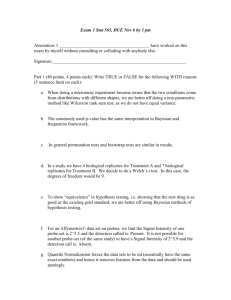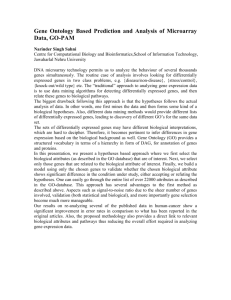
This work is licensed under a Creative Commons Attribution-NonCommercial-ShareAlike License. Your use of this
material constitutes acceptance of that license and the conditions of use of materials on this site.
Copyright 2006, The Johns Hopkins University and Karl Broman. All rights reserved. Use of these materials
permitted only in accordance with license rights granted. Materials provided “AS IS”; no representations or
warranties provided. User assumes all responsibility for use, and all liability related thereto, and must independently
review all materials for accuracy and efficacy. May contain materials owned by others. User is responsible for
obtaining permissions for use from third parties as needed.
Outline
The essentials of
microarray data analysis
• Experimental design
• Take logs!
• Pre-processing: affy chips and 2-color arrays
(from a complete novice)
• Clustering
• Identifying differentially expressed genes
Thanks to Rafael Irizarry for
the slides!
2
Biological question
Differentially expressed genes
Sample class prediction etc.
Resources
Experimental design
• Expressionists working group
(Search google for “hopkins expressionists”)
“Top ten things to know…” held monthly
Microarray experiment
16-bit TIFF files
• “Stats for gene expression” course (140.688)
Image analysis
http://www.biostat.jhsph.edu/~ririzarr/Teaching/688
(Rfg, Rbg), (Gfg, Gbg)
Normalization
R, G
Estimation
3
Testing
Clustering
Biological verification
and interpretation
Discrimination
4
1
Experimental design
Experimental design
• Choice of platform
• Array design
Proper experimental design is needed to ensure that
questions of interest can be answered and that this can be
done accurately and precisely, given experimental
constraints, such as cost of reagents and availability of
mRNA.
– Creation of probes
– Location on the array
– Controls
• Target samples
5
6
Preparing mRNA samples:
Avoidance of bias
Mouse model
Dissection of
tissue
• Conditions of an experiment (mRNA extraction and processing,
the reagents, the operators, the scanners and so on) can
leave a “global signature” in the resulting expression data.
Biological Replicates
RNA
Isolation
– Balance
– Randomization
Amplification
Technical replicates
Probe
labelling
Hybridization
7
8
2
Technical replication - amplification
Two-color layouts
• 3 sets of two different samples performed on different days
• #10 and #12 were from the same RNA isolation and amplification
For two color platforms it is assumed that the size of the
spot/probe effect is too big to trust the absolute intensites. Thus
we always use relative measurements
• #12 and #18 were from different dissections and amplifications
• All 3 data sets were labeled separately before hybridization
Vertices: mRNA samples; Edges: hybridization;
Direction: dye assignment.
Cy3
sample
Cy5
sample
Data provided by
Dave Lin (Cornell)
9
10
Experiment for which a
number of designs are
suitable for use
Common reference design
T1
T2
Tn-1
Tn
Time Series
Ref
Experiment for which the common reference design is appropriate
Meaningful biological control (C) Identify genes that responded differently / similarly
across two or more treatments relative to control.
Large scale comparison. To discover tumor subtypes when you have many different tumor
samples.
T1
T2
T3
T4
Ref
T1
T2
T3
T4
T1
T2
T3
T4
Advantages:
Ease of interpretation.
Extensibility - extend current study or to compare the results from current study to other
array projects.
T1
11
T2
T3
T4
12
3
Pooling: looking at very small amount of tissues
Pooling
Mouse model
Dissection of
tissue
• Should I pool mRNA samples across subjects
in an effort to reduce the effect of biological
variability?
RNA
Isolation
• Notice, in many cases, samples are cheap but
arrays are expensive
Pooling
Probe
labelling
Hybridization
13
14
Alternative pooling
strategy
Problem with pooling
everything
• Instead of pooling everything, how about
pooling groups?
• For example, will I obtain the same
results with 12 individuals on 12 chips as
with 12 individuals on 4 chips ?
• You cannot measure variability
• You cannot take logs before “averaging”
15
16
4
Design 1
Pooled vs Individual
samples
More on Pooling and outliers
Design 2
Taken from
Kendziorski etl al (2003)
17
18
Images of probe level
data
Outline
• Experimental design
• Take logs!
• Pre-processing: affy chips and 2-color arrays
• Clustering
• Identifying differentially expressed genes
This is the raw data
19
20
5
Images of probe level
data
Outline
• Experimental design
• Take logs!
• Pre-processing: affy chips and 2-color arrays
• Clustering
• Identifying differentially expressed genes
Log scale version much more informative
21
22
Work flow
Affymetrix GeneChip
Design
Raw data (.DAT files)
5’
Image analysis
3’
Probe intensities (.CEL files)
Pre-processing
normalization
Reference sequence
Expression measures (tables)
…TGTGATGGTGGGGAATGGGTCAGAAGGCCTCCGATGCGCCGATTGAGAAT…
CCCTTACCCAGTCTTCCGGAGGCTA Perfectmatch
CCCTTACCCAGTGTTCCGGAGGCTA Mismatch
Statistical test
Rank (list)
Choose filter
Significance level
NSB & SB
NSB
Candidate genes (short list)
23
24
6
Affy Technical Replicates
Boxplot
Self-self hybridization
log2 R vs. log 2 G
Different scanners were used.
25
26
Self-self hybridization
Self-self hybridization
M vs. A
M vs. A
Robust local regression
within sectors
(print-tip-groups)
of intensity log-ratio M
on average log-intensity A.
M = log 2R - log 2G, A = (log 2R + log 2G)/2
27
M = log 2R - log 2G, A = (log 2R + log 2G)/2
28
7
Boxplots by print-tip-group
What can we do?
• Throw away the data and start again? Maybe.
• Statistics offers hope:
– Use control genes to adjust
– Assume most genes are not differentially expressed
– Assume distribution of expression are the same
Intensity
log-ratio, M
29
Simplest Idea
30
How does it work
• Assume all arrays have the same median log expression or
relative log expression
• Subtract median from each array
• In cDNA this makes the median log ratio 0 (we assume there
are as many over-expressed as under-expressed)
• In Affy we usually add a constant that takes us back to the
original range
Notice subtracting in the original scale won’t work well
31
32
8
How does it work
The medians match but there are some discrepancies
What are the consequences
33
Quantile normalization
These are two technical replicates with spike-ins.
34
How does it work
• All these non-linear methods perform similarly
• Quantiles is my favorite because its fast
• Basic idea:
–
–
–
–
order value in each array
take average across probes
Substitute probe intensity with average
Put in original order
35
36
9
How does it work
Before and
Does it wash away real differential expression?
37
These are two technical replicates. Only the red are differentially expressed
38
Outline
After quantile normalization
• Experimental design
• Take logs!
• Pre-processing: affy chips and 2-color arrays
• Clustering
• Identifying differentially expressed genes
39
40
10
Clustering is not a
universally good tool
Outline
• Experimental design
• Take logs!
• Pre-processing: affy chips and 2-color arrays
• Clustering
• Identifying differentially expressed genes
41
Work flow
42
Differential gene expression
Raw data (.DAT files)
Image analysis
• Identify genes whose expression levels are associate with a
response or covariate of interest
Probe intensities (.CEL files)
– clinical outcome (e.g. survival, response to treatment, tumor class)
Pre-processing
normalization
– covariate such as treatment, dose, time.
• Estimation: In a statistical framework, assigning a score can be
viewed as estimating an effects of interest (e.g. difference in
means, slope, interaction). We can also take the variability of
these estimates into account.
Expression measures (tables)
Statistical test
• Testing: In a statistical framework, deciding on a cut-off can be
viewed as an assessment of the statistical significance of the
observed associations.
Rank (list)
Choose filter
Significance level
Candidate genes (short list)
43
44
11
Example: Two populations
•
A common problem is to find genes that are differentially expressed in
two populations.
•
Many method papers appear in both statistical and molecular biology
literature.
•
The proposed scores range from:
Should we consider variability?
– ad-hoc summaries of fold-change
– variantes on the t-test
– and posterior means obtained from Bayesian or empircal Bayes
methods.
•
What's the difference? Mainly the way in which the variation within
population is incorporated
45
Should we consider variability?
46
Should we consider variability?
47
48
12
Useful Plots
Example
• The MA plot shows M=log fold change, plotted against
A=average log intensity
• If we have various replicates in each population we can plot
M=difference in log averages in two populations
• The volcano plot shows, for a particular test, - log p-value
against the effect size (M)
49
If you insist on using MAS 5.0
it really helps
50
Summary
• Experimental design is critical
– Biological vs technical replicates
• Pre-processing (calibration) can have an
enormous effect on the end results
• Analysis should be guided not by what others
have done, but by what you want to learn.
• Regarding multiple testing: view this process
as exploratory, and don’t get hung up on
adjustments for multiple testing.
51
52
13








